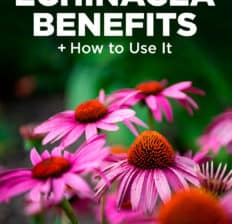This Dr. Axe content is medically reviewed or fact checked to ensure factually accurate information.
With strict editorial sourcing guidelines, we only link to academic research institutions, reputable media sites and, when research is available, medically peer-reviewed studies. Note that the numbers in parentheses (1, 2, etc.) are clickable links to these studies.
The information in our articles is NOT intended to replace a one-on-one relationship with a qualified health care professional and is not intended as medical advice.
This article is based on scientific evidence, written by experts and fact checked by our trained editorial staff. Note that the numbers in parentheses (1, 2, etc.) are clickable links to medically peer-reviewed studies.
Our team includes licensed nutritionists and dietitians, certified health education specialists, as well as certified strength and conditioning specialists, personal trainers and corrective exercise specialists. Our team aims to be not only thorough with its research, but also objective and unbiased.
The information in our articles is NOT intended to replace a one-on-one relationship with a qualified health care professional and is not intended as medical advice.
9 Echinacea Benefits and Uses — from Colds to Cancer
September 8, 2023

If you’ve researched antiviral herbs that help combat the common cold or flu, you probably came across echinacea — a powerful plant that’s currently booming in the natural health market.
What’s behind the surging popularity in this magnificently attractive flower? It’s because echinacea benefits our health and well-being like few plants on the planet. Now that’s something to get behind.
Once known as an alternative way to prevent the common cold, now echinacea is quickly becoming known for multiple uses and benefits — from helping combat cancer to alleviating pain.
And guess what? You don’t have to purchase echinacea products throughout the year to prevent illness. Instead, try making your own extract to take advantage of this plant’s incredible healing properties.
What Is Echinacea?
Echinacea is a native North American coneflower that was discovered and used as a traditional herbal remedy for more than 400 years by the Great Plains Indian tribes. Technically classified as an herb, several species of the echinacea plant are used to make medicine from its flowers, leaves and roots.
Prior to 1950 and the introduction of antibiotics, echinacea held an esteemed medicinal status. As the health care industry shifted, antibiotics became the rage, and the famed herb lost much of its esteem.
It’s become a popular plant to grow in North America, however. Also called Echinacea purpurea, commonly known as the pale purple coneflower, the echinacea plant is a favorite of gardeners and butterfly enthusiasts. An attractive flower that resemble daisies with mounded heads and rose, pink or purple petals, it grows on strong stems far above the foliage.
Most people don’t realize that the chemicals contained in the root differ significantly from those in the upper part of the plant. If we analyze the roots of the purple coneflower, we can see that they have high concentrations of volatile oils, while the parts that grow above the soil tend to contain more polysaccharides that are known to trigger immune function.
Echinacea extract is essentially a tincture from this upper part of the plant.
Many of echinacea’s chemical constituents are, in fact, powerful immunity stimulators and can provide a significant therapeutic value, which is why the plant is often used for treating the common cold. A few echinacea constituents that you’re probably familiar with are essential oils, flavonoids, inulin, polysaccharides and vitamin C.
On top of reports of the plant’s highly nutritious extracts, we’ve learned that the portion of the plant that grows above ground is the most effective. Interestingly, in Germany, dietary herbs are regulated by the government, and above ground parts of the Echinacea purpurea species are actually approved as natural remedies for preventing and treating urinary tract infections, upper respiratory tract infections, colds and slow-healing wounds.
Related: Usnea Benefits for the Kidneys, Immunity, Respiratory System & More
Health Benefits
What are the benefits of taking echinacea? Although there seems to be an infinite number of echinacea benefits, these nine stand out.
1. Helps Combat Cancer
Fascinating research about echinacea benefits regarding brain cancer has been published by the National Institutes of Health (NIH). Researchers state that the “medicinal value of phytochemicals contained in Echinacea is clearly evident and indicates that these agents, as well as phytochemicals not yet discovered in other herbs, may be valuable tools to combat tumors.”
The use of echinacea as another alternative cancer treatment is now being recommended, literally, “alongside — or indeed in place of — conventional therapy,” according to researchers.
2. Boosts the Immune System
How does echinacea help with treating the common cold? Published in the journal Lancet Infectious Diseases, the University of Connecticut performed a meta-analysis study that evaluated the effects of echinacea using 14 studies.
It was determined that:
- Echinacea can reduce the chances of catching a common cold by 58 percent.
- Echinacea reduces the duration of the common cold by almost 1.5 days.
Craig Coleman, assistant professor of pharmacy practice and lead author of the study, added that, “The take home message from our study is that echinacea does indeed have powerful cold prevention and cold treatment benefits.”
This is exactly why echinacea products are one of several effective remedies for preventing and treating colds.
Dr. Coleman found that “the significance of that finding becomes clear when you consider that Americans suffer from one billion colds annually and spend about $1.5 billion annually for doctor’s visits and another $2 billion annually on non-prescription cough and cold treatments.”
The United States Department of Agriculture Natural Resources Conservation Service reports that the immune system seems to be strongly influenced by the level of the echinacea dose. It appears that 10 milligrams of echinacea per one kilogram of body weight, taken daily over a 10-day period, is effective as an immunity stimulant.
In addition, the medical journal Hindawi published material suggesting that echinacea stops viral colds. However, the most significant results of echinacea benefits were the effects when used on recurring infections.
To date, research shows that the plant probably reduces cold symptoms, but it seems that the effects of echinacea are more powerful once cold symptoms start.
Another study, this one published in Virus Research, evaluated the effects of echinacea against viral and secondary bacterial infections that often follow. Plant extracts were able to fight viral respiratory infections, including the flu, while also reducing inflammation and lowering the risk of developing bacterial complications.
Therefore, you can see from several controlled trials why echinacea products are used for viral illnesses, such as the common cold and flu, particularly extracts. They are a favorite recommendation for integrative physicians, homeopaths, naturopaths and more for their patients.
3. Alleviates Pain
Echinacea’s history began when Echinacea purpurea was used by the Great Plains Indians as a painkiller. It’s an especially effective pain reliever for the following types:
- Pain in the bowels
- Pain associated with headaches
- Pain associated with HSV (herpes)
- Pain associated with gonorrhea
- Pain associated with measles
- Snake bites
- Sore throats
- Stomach ache
- Tonsillitis
- Toothache
Recent research suggests that Echinacea purpurea and angustifolia activate the endocannabinoid system, enhancing its pain-relieving effects. In in vitro and vivo studies, the herb has proven to reduce inflammatory pain, such as arthritis and burns.
Some common ways to use echinacea products to combat pain are to drink herbal echinacea tea or make a paste out of the dried herb and rub it directly on the area that is affected.
4. Functions as a Laxative
Like many herbs, echinacea is particularly healing for the stomach and entire gastrointestinal tract. According to Medical Herbalism, for example, it has been shown to work as a mild laxative that provides constipation relief and works as a calming agent.
Drinking the herbal tea is especially effective to help with this. For more chronic conditions, a cup of tea every day can help loosen the bowels — whereas two to three cups per day can help with sudden bouts.
However, to reduce the risk of side effects, be sure not to overuse this herb. To be safe, be sure to limit your tea to two cups a day, max, and take supplements as directed on their labels.
5. Acts as Anti-Inflammatory Agent
Inflammation is at the root of most diseases. Various factors — including stress, toxins in our food and poor sleep — all contribute.
Thankfully, as explained by the University of British Columbia, regular echinacea consumption can effectively reverse and alleviate various types of inflammation.
Products containing echinacea may even help with uveitis, or eye inflammation. It’s a good idea for people who struggle with chronic inflammatory conditions, like rheumatoid arthritis, to regularly consume the herbal tea in order to reduce system-wide inflammation.

6. Helps Treat Skin Problems
Echinacea benefits the skin as well, including improving skin hydration and reducing wrinkles. Research shows that using skin products containing the plant’s extracts may help to boost skin health. Plus, it show no side effects, like skin irritation.
7. Helps Improve Mental Health
Echinacea angustifolia is the recommended species to help with specific ailments related to ADD/ADHD.
In a survey of herbal use in children with ADHD disorder or depression, echinacea was among the most common herbal medicines given for behavioral symptoms. Eighty-three percent of caregivers said they gave herbal medicines alone, whereas 13 percent gave herbal medicines with prescription drugs with the supervision of a health care professional.
Both adults and children suffering from ADD/ADHD have a higher-than-normal chance of experiencing emotional disturbances, especially:
- Anxiety
- Depression
- Social phobias
Again, dosage is key. It’s recommended that people only take 20 milligrams at a time and no more.
In fact, taking more than 20 milligrams per dose can actually cancel out the echinacea benefits that relieve anxiety.
8. Relieves Upper Respiratory Issues
Because of its immune-boosting and anti-inflammatory effects, research indicates that this herb may work to improve the following upper respiratory symptoms:
- Acute sinusitis
- All flus
- Asthma
- Common cold
- Croup
- Diphtheria
- Inflammation
- Strep throat
- Tuberculosis
- Whooping cough
In fact, in a clinical study of asthma sufferers, echinacea acted similarly to classic synthetic drugs in treating asthma. Researchers wrote, “Recent studies have shown that secretion of asthma-related cytokines in the bronchial epithelial cells can be reversed by Echinacea preparations.”
In particular, echinacea showed significant bronchodilatory and anti-inflammatory effects. Study authors concluded that this “provide(s) a scientific basis for the application of this herb in traditional medicine as a supplementary treatment of allergic disorders of the airways, such as asthma.”
For more severe issues, supplement products are the way to go as drinking tea, for instance, is just not concentrated enough.
9. Fights Infection
Echinacea is also a fantastic remedy for a whole slew of infections. One study found that taking echinacea and applying a medicated cream to the skin can lower the rate of reoccurring vaginal infections by to 16 percent compared to simply taking the medicine alone.
It’s also known to help with:
- Bloodstream infections
- Genital herpes
- Gum disease
- Malaria
- Syphilis
- Typhoid
- Urinary tract infections
- Vaginal yeast infections
Uses
Echinacea is used for the prevention and treatment of several common issues, from the common cold to aging skin. Here are the herb’s top uses as indicated by controlled trials and reviews of research:
1. Helps Prevent Catching a Cold
A review of 82 studies published in 2018 in Evidence-Based Complementary and Alternative Medicine concluded that echinacea use — 2,400 milligrams of extract/day — for four months may help keep you from catching a cold or at least reduce the severity and duration of symptoms of you do catch one.
2. Reduces Cold Symptoms and Duration of Cold
A meta-analysis of studies published in 2015 in the Journal of the American Medical Association found that echinacea use, if started when the first symptoms appear, may help modestly reduce the duration and severity of the common cold.

3. Helps Avoid the Flu
A cell study published in 2009 showed that various types of flu viruses, including potentially lethal bird flu and swine flu, were unable to infect cultured human cells that had been exposed to echinacea extract.
While lab study findings do not always prove true in living humans, these results — combined with the results of human studies showing the benefits of echinacea uses in humans — suggest that the herb may be worth trying right away if you’ve been exposed to someone with flu or it is “going around” in your area.
4. Reduces Flu Symptoms and Duration of Illness
A study out of Europe published in 2015 revealed that echinacea was as effective as the prescription medication Oseltamivir for lessening the severity and duration of flu symptoms as well as preventing adverse effects when started at the first sign of infection. It’s important to take echinacea at the first sign of flu symptoms to be most effective.
In addition, other echinacea uses supported by research include helping:
- combat cancer
- boost immunity
- alleviate pain
- treat constipation
- fight inflammation
- improve skin
- support mental health
- relieve upper respiratory issues
Risks and Side Effects
It’s important to know that there may be side effects to taking too much echinacea. In some cases, high doses of the plant’s extracts can sometimes cause nausea and dizziness, particularly in those who have allergies. Therefore, it’s not considered safe to use for treatment of seasonal allergies, for example.
It has also been reported that injected echinacea can cause more severe reactions, such as:
- diarrhea
- disorientation
- dizziness
- dry mouth
- fever
- headache
- insomnia
- joint and muscle aches
- nausea
- numbness of the tongue
- sore throat
- stomach pain
- unpleasant taste
- vomiting
It’s also possible have an allergic reaction to echinacea, so starting slowly, in small doses, is important.
The bottom line when it comes to the plant’s side effects: Don’t exceed ingesting safe and recommended amounts. To avoid long-term, excessive use, take a break every few weeks if you are using supplements regularly.
Forms and Dosage
Echinacea is available over the counter in many places, including health food stores, online and even pharmacies and supermarkets. It’s sold in many different forms, including liquid extracts, dried herb, capsules or pills, and even as echinacea tea. Sometimes it’s combined with the herb goldenseal in some immune support supplements.
Although there is no formal proof on how to best use echinacea, the NIH offers the advice that regular daily use is definitely beneficial for immunity and overall health. For this reason, it’s often used for the common cold and flu.
Some sources says that echinacea seems to be most effective when taken as soon as symptoms appear and taken many times a day for seven to 10 days. It’s also believed that liquid forms of echinacea may prove more effective than capsules, which is due to the absorption rate.
Whether or not you’re using it for yourself or your children, always remember to use an alcohol-free preparation.
As a final note of caution, it’s sadly common that products are mislabeled as the species of echinacea or the preparations don’t contain the labeled amount of ingredients. That’s why it’s so important for people to use products from trusted and transparent brands.
Conclusion
- There are many traditional echinacea benefits and uses, but the strongest scientific evidence available currently supports echinacea use (as echinacea extract or echinacea tea) as a way to help slow the development and reduce the intensity and duration of upper respiratory viral infections, such as the common cold and influenza (flu).
- Other echinacea uses supported by controlled trials include helping combat cancer, boosting immunity, alleviating pain, treating constipation, fighting inflammation, improving skin and more.
- You can grow your own echinacea and make your own homemade extract to try out the power of echinacea uses, but start slow and in small doses to avoid allergic reactions to the herb or other adverse side effects.














